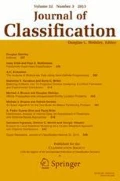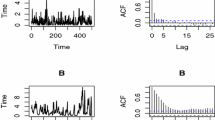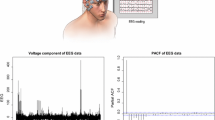Abstract
An EM algorithm for fitting mixtures of autoregressions of low order is constructed and the properties of the estimators are explored on simulated and real datasets. The mixture model incorporates a component with an improper density, which is intended for outliers. The model is proposed as an alternative to the search for the order of a single-component autoregression. The methods can be adapted to other patterns of dependence in panel data. An application to the monthly records of income of the outlets of a retail company is presented.
Similar content being viewed by others
References
BANFIELD, J.D., and RAFTERY, A.E. (1993), “Model-Based Gaussian and Non-Gaussian Clustering”, Biometrics, 49, 716–723.
CHATFIELD, C. (2004), The Analysis of Time Series: An Introduction, Boca Raton: Chapman and Hall/CRC.
CORETTO, P., and HENNIG, C. (2010), “A Simulation Study to Compare Robust Clustering Methods Based on Mixtures”, Advances in Data Analysis and Classification, 4, 111–135.
DEMPSTER, A.P. (1972), “Covariance Selection”, Biometrics, 28, 157–175.
DEMPSTER, A.P., LAIRD, N.M., and RUBIN, D.B. (1977), “Maximum Likelihood for Incomplete Data Via the EM Algorithm”, Journal of the Royal Statistical Society Series B, 39, 1–38.
FRALEY, C., and RAFTERY, A.E. (2002), “Enhanced Software for Model-Based Clustering, Discriminant Analysis and Density Estimation”, Journal of the American Statistical Association, 97, 611–631.
GARCÍA-ESCUDERO, L.A., GORDALIZA, A., MATRÁN, C., and MAYO-ISCAR, A. (2011), “Exploring the Number of Groups in Robust Model-Based Clustering”, Statistics and Computing, 21, 585–599.
HENNIG, C. (2004), “Breakdown Points for Maximum Likelihood Estimators of Location- Scale Mixtures”, Annals of Statistics, 32, 1313–1340.
HENNIG, C., and CORRETTO, P. (2008), “The Noise Component in Model-Based Cluster Analysis”, in Data Analysis, Machine Learning and Applications, eds. C. Preisach, H. Burkhardt, L. Schmidt-Thieme, and R. Decker, Berlin: Springer-Verlag.
LITTLE, R.J.A., and RUBIN, D.B. (2002), Statistical Analysis with Missing Data, New York: Wiley and Sons.
LONGFORD, N.T. (2008), Studying Human Populations. An Advanced Course in Statistics, New York: Springer-Verlag.
LONGFORD, N.T. (2012), “ ‘Which Model’ Is the Wrong Question”, Statistica Neerlandica, 66, to appear, DOI:10.1111/j.1467-9574.2011.00517.x .
LONGFORD, N.T., and D’URSO, P. (2011), “Mixture Models with an Improper Component”, Journal of Applied Statistics, 38, 2511–2521.
LONGFORD, N.T., and PITTAU, M.G. (2006), “Stability of Household Income in the European Countries in the 1990’s”, Computational Statistics and Data Analysis, 51, 1364–1383.
McLACHLAN, G.J., and PEEL, D. (2000), Finite Mixture Models, New York: Wiley.
MENG, X.-L., and RUBIN, D.B. (1991), “Using EM to Obtain Asymptotic Variance Covariance Matrices: The SEM Algorithm”, Journal of the American Statistical Association, 86, 899–909.
MENG, X.-L., and VAN DYK, D. (1997), “The EM Algorithm—An Old Folk-Song Sung to a Fast New Tune”, Journal of the Royal Statistical Society, Series B, 59, 511–567.
R Development Core Team (2009), R : A Language and Environment for Statistical Computing, Vienna, Austria: R Foundation for Statistical Computing.
RICHARDSON, S., and GREEN, P.J. (1997), “On Bayesian Analysis of Mixtures with an Unknown Number of Components”, Journal of the Royal Statistical Society, Series B, 59, 731–792.
RUBIN, D.B. (2002), Multiple Imputation for Nonresponse in Surveys, New York: Wiley and Sons.
TANNER, M.A., and WONG, W.H. (1987), “The Calculation of the Posterior Distribution by Data Augmentation”, Journal of the American Statistical Association, 82, 528–550.
Author information
Authors and Affiliations
Corresponding author
Additional information
Partial support by the Grant SEJ–2006–13537 from the Spanish Ministry of Science and Technology and the Grant GAČR 402/09/0515 from the Science Foundation of the Czech Republic is acknowledged. The data were obtained from a source that wishes its identity not to be disclosed. Helpful comments and suggestions of Aleix Ruiz de Villa Robert and three anonymous referees are acknowledged.
Rights and permissions
About this article
Cite this article
Longford, N.T., D’Urso, P. Mixtures of Autoregressions with an Improper Component for Panel Data. J Classif 29, 341–362 (2012). https://doi.org/10.1007/s00357-012-9111-6
Published:
Issue Date:
DOI: https://doi.org/10.1007/s00357-012-9111-6




